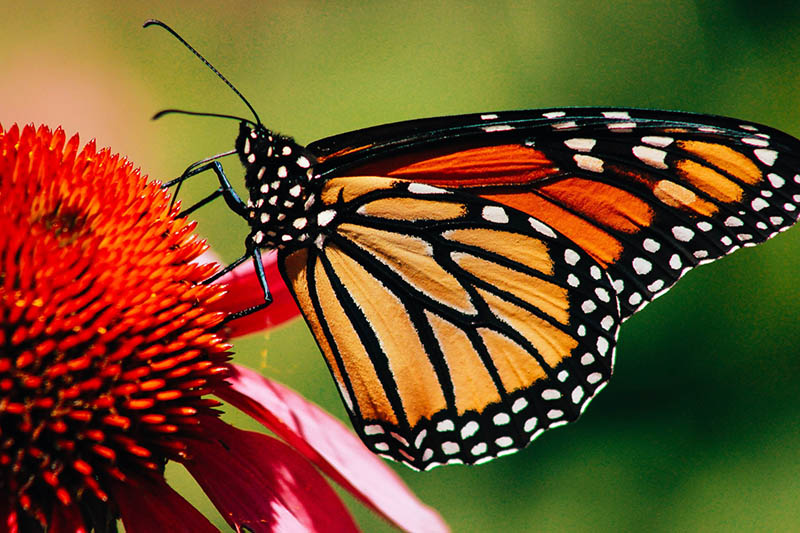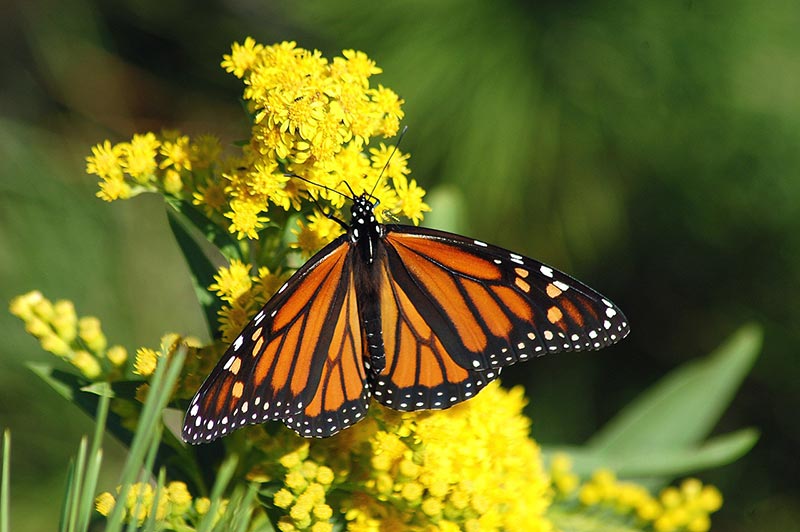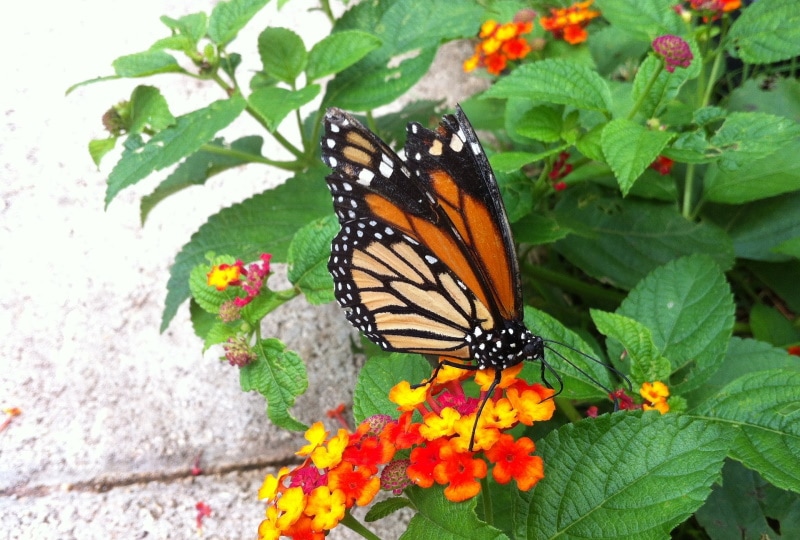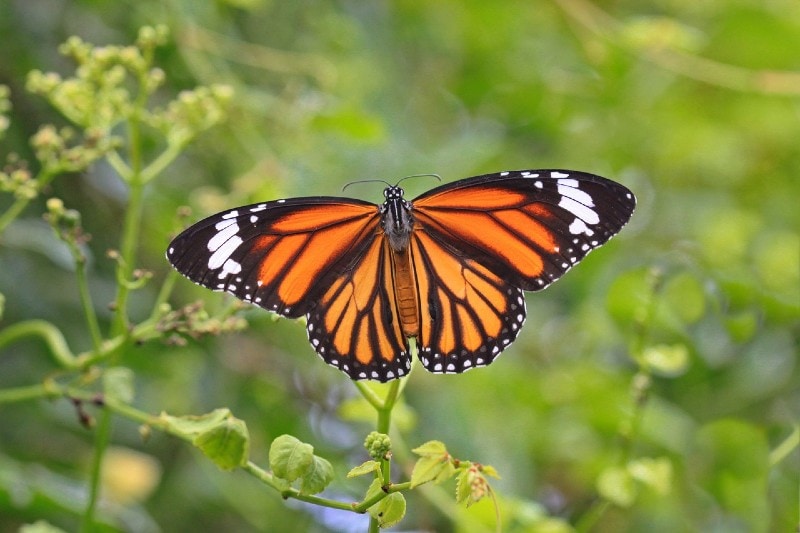Are Monarch Butterflies Poisonous? The Interesting Answer
-
Pete Ortiz
- Last updated:

Monarch butterflies are among the most popular and instantly recognized butterflies worldwide. With bold orange and jet-black coloring, the monarch is a symbol of transformation in many cultures. But are there any dark sides to this beautiful summertime favorite?
If you heard a rumor that monarch butterflies are poisonous—could this accusation bear truth? The answer is—yes! Maybe they aren’t toxic to humans, but they certainly can harm predators. However, don’t think they fail to give them a proper warning first. Let’s learn what makes the monarch butterfly poisonous.
Monarch Butterflies + Milkweed = Toxicity
If you are a huge fan of watching butterflies feed, you’ll notice that a monarch’s favorite food source is milkweed. Milkweed is a unique, wild-growing plant with a milk-like compound in the leaves and stalks. They flower in beautiful sprawled-headed blooms that attract butterflies from all over.
However, that’s not where the monarch’s relationship with milkweed begins. Monarch caterpillars start feasting first. So, if you’re looking to spot a monarch before the transition to flight, you can find these caterpillars from late April to June.

Milkweed: Why Is It So Toxic?
Milkweed, or Asclepias, is a common wild plant many people choose to have in their garden space. Besides the plant’s beauty, it is the only foliage monarchs lay eggs on. Plus, it’s a terrific food source for pollinators.
Even though it is lovely and sustaining for wildlife, it is abundantly toxic to most living creatures. Monarchs and a select few other insects can feast on milkweed with no consequence.
What surprises researchers is that milkweed has a highly poisonous compound called cardiac glycosides. Typically, these glycosides disrupt molecular pumps that control blood flow within themselves. So, how exactly do monarchs metabolize this substance?
The monarch butterfly has a mutation that protects them from the substance. They can digest and obtain nourishment from this food source while not showing the present toxin in their system. Even though it isn’t poisonous to these butterflies, the butterfly itself would be totally poisonous if ingested.
How Toxic Are Monarchs?
If a bird or other predator tries to eat a monarch butterfly or a caterpillar, it will make them tremendously sick. However, it’s not enough to kill them. So, if a bird consumes one of these beauties, it will learn very quickly to steer clear next time.
Monarchs Warn Predators of Toxicity
You could never say that a monarch doesn’t tell someone they mean business. Their orange and black coloration actually has a particular purpose. This warns potential predators around them that they are, in fact, toxic and will do great harm if ingested.
So, most predators know right away to stay away from these beautiful, but dangerous butterflies. Butterflies are no issue to humans, but the same cannot be said for birds and other insects.
Monarchs Don’t Need to Compete for Food
Because the monarch butterfly has specifically evolved to tolerate the toxins in milkweed, they have a natural defense to the plant. They don’t have to ward off other food competitors, as they are the only ones who will be feasting on this otherwise toxic foliage.
Because milkweed is toxic to most other things, it also ensures the life stage transitions between caterpillar and adult butterfly. Since most creatures and critters aren’t going to be near the milkweed plants, many monarchs find solace and safety in it.
Monarchs don’t visit just one type of milkweed, either. They utilize several different species in the milkweed category to support their life cycles. While they might not need to compete with other butterflies or similar insects for their food source, milkweed attracts a series of unwanted pests.
Threats to Milkweed
Aphids are one of the most problematic pests of milkweed. They can make this plant unhealthy and not a fantastic food source for monarchs. But don’t worry; other insects are on the trail here as well.
The ever-so-popular ladybug is one of the main insects you might see on a milkweed plant. But these ladybugs are non-toxic. They are not eating the milkweed plant’s juices, nectar, or flowers. They are after the aphids.
Ladybugs are immensely efficient hunters, so they will take care of a lot of the potential pests that milkweed could have. So, the ladybug and monarch work together for the same result.

The Monarch’s Non-Toxic Twin
We have another butterfly we would like to discuss that does not pose a risk to anything. The viceroy is a beautiful monarch look-alike that is similar in color and size. However, these butterflies are completely non-toxic, with an evolutionary advantage.
This adaptation is incredibly intelligent and lifesaving for this particular butterfly species. Because they resemble the toxic monarch, predators are much less likely to try to mess with them. So, they simply get to flutter around being beautiful and completely non-threatening, and no one seems to mess with them.
Viceroy vs. Monarch: How to Tell the Difference
Monarch and viceroy butterflies both have vibrant orange wings, black borders, and white dots on their bodies. So, at first glance, an inexperienced and even intermediate-level eye might be unable to detect the difference.
During the caterpillar stage, it’s effortless to tell the difference between a monarch and a viceroy butterfly. The caterpillars look incredibly different. The viceroy has a fascinating caterpillar look, and both the monarch and the viceroy have different feeding hosts during the caterpillar stage.
The viceroy caterpillar is often described as looking like bird poop. That is an excellent evolutionary advantage to remain camouflaged in their environment. The monarch butterfly isn’t shy, though. They are chunky, smooth caterpillars that are yellow-green, white and black-banded.
Their food sources in the caterpillar stage are quite different as well. Viceroys feed on willows and poplars, being found in these wooded locations. But monarch caterpillars feed only on milkweed, as we discussed before.
As both of these butterflies transition, the adults feed on many of the same types of flowers. You might find them fluttering around boneset, field thistle, goldenrod, ironweed, and Joe-Pye weed. However, if you see a beautiful butterfly on milkweed, this is undoubtedly a monarch, not a viceroy.
The viceroy continues to thrive in many United States areas, but the monarch population is decreasing rapidly. In fact, according to the US Fish and Wildlife Service, the monarch butterfly is an endangered species.

Conclusion
If you absolutely love butterflies, you surely don’t plan on eating one. So, the toxicity of the monarch does not affect human beings. It only affects the predators that are silly enough to try to eat them despite their bright, colorful warning of toxicity.
If you want to attract butterflies into your garden, watching a monarch develop from caterpillar to adult, you can always add some milkweed to your garden space.
Featured Image Credit: Erin Minuskin, Unsplash
Contents


